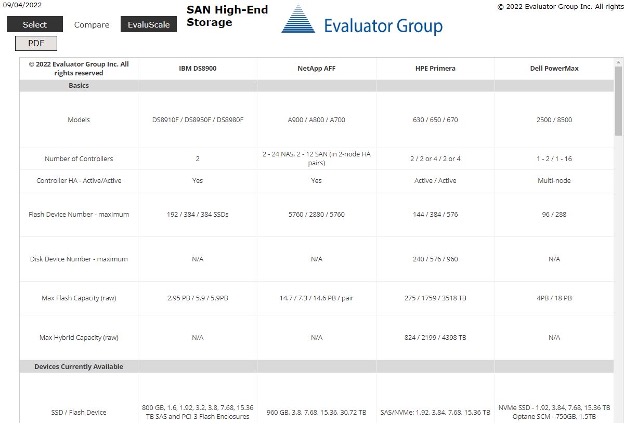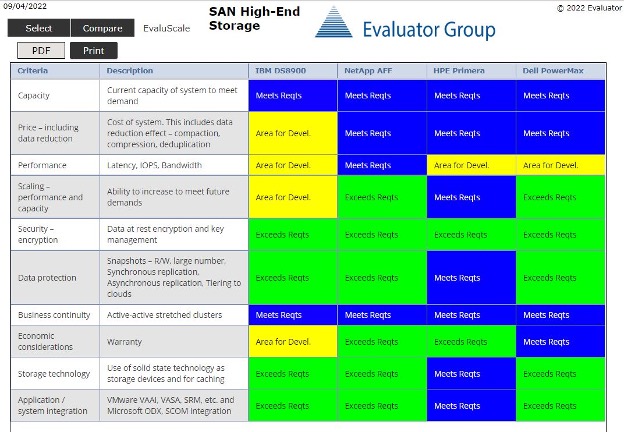This website uses cookies so that we can provide you with the best user experience possible. Cookie information is stored in your browser and performs functions such as recognising you when you return to our website and helping our team to understand which sections of the website you find most interesting and useful.
This is Part 4 of this blog series. Read Part 3 here.
This is the fourth installment in a series about considerations for IT in changing storage vendors and storage systems. Changing storage vendors is a decision that is not taken without careful consideration by IT professionals and has significant implications. This series examines the evaluation of vendor storage solutions as part of the decision to change storage vendors.
Part 3 gave some of the common considerations for evaluating a storage solution as part of a vendor change. The common elements and the criteria for evaluation were explained for block, file, and object access methods. This part will deal with specifics for block storage evaluation.
Evaluating a Block Storage Solution
There are different block storage solutions for enterprises that may be considered when changing vendors and storage. Most enterprises will have SAN attached storage system with Fibre Channel or Ethernet networks. Other solutions include captive storage on servers call Direct Attached Storage which is seen in Hyper Converged Infrastructure systems in enterprise and disaggregated storage solution. Disaggregated storage is usually connected through a network to servers with storage function software called Software Defined Storage or, in the case of container environments, Container Native Storage software executing on the attached servers. The requirements for storing and managing data are basically the same with storage function software running on external storage systems or on all attached servers that possibly are competing for resources with applications.
The focus for changing storage vendors is on replacing existing storage systems with like systems. Changing infrastructure architecture at the same time as changing the vendor is a larger project but the evaluation requirements are relatively the same. This description is about block storage and the evaluation required to make a selection.
Valuable Information to Aid in Evaluation
The Evaluator Group has extensive information regarding different storage solutions including product analysis, comparative information, evaluation guides and the Evaluation Group analyst opinions about how well product meet criteria. A short description, example, and link to these areas on the Evaluator Group website should be useful. The material is updated as new product updates (and new products) are released.
Evaluation Guide
The evaluation guide for block storage covers several areas:
- SAN Storage Evaluation Guide | Evaluator Group
- Software Defined Storage Evaluation Guide | Evaluator Group
- Hyperconverged Evaluation Guide | Evaluator Group
- Storage Virtualization Evaluation Guide | Evaluator Group
Comparison Matrices
The comparison matrices are in two forms: one that is a PDF with comparison of products (in this case, block storage systems) in a category such as high-end SAN storage systems and another is an interactive comparison matrix where up to four products may be compared against each other. A shortened sample of the interactive matrix follows:
The analyst opinions as to meeting criteria is in the EvaluScale matrix. A sample follows:
Evaluation Consideration for Block Storage (not included in the Common Considerations in Part 3)
Business Continuity
Block storage is predominantly used with business-critical applications. This means that not only must the data be available, it must be available for seamless operation between two different locations, separated by a “metro” distance (usually less than 300KM). For open systems environments, this is termed “active-active stretched clusters” where data is available at both locations in case one site has a failure and the failover/takeover continues operations at the remote site. This is usually done by storage systems with synchronous replication and storage system software and can be a differentiation element for storage in the evaluation. In mainframe environments, the business continuity is done through operating system functionality such as Globally Dispersed Parallel Sysplex (GDPS). For container management environments, stretched clusters are implemented through software with Container Native Storage or through external storage systems depending on infrastructure.
Performance Specifics
As noted in Part 3 for the common storage evaluation characteristics, performance includes bandwidth and IOPS. For block storage systems, usually response time from storage is a more important element to consider. Response time drives IOPS. Minimal response time, when measured the same, is a competitive issue for vendors and can make a significant difference in transaction processing. Some applications do need high bandwidth, requiring that to be considered in the evaluation for storage. Most information on performance is reported by vendors so caution should be taken.
Data Migration
Making a change means that the existing data will have to be migrated to a new system. For block storage, this means moving volumes (LUNs) from one storage system to another. Most IT operations do not have the luxury of taking a system out of service while data is moved, so solutions to migrate data are employed. Some storage systems have built-in migration capabilities. An example of this is the Spectrum Virtualize software from IBM used in IBM FlashSystems. Externally attached storage systems can be virtualized by the FlashSystem and migrated on a user defined schedule, transparent to operations. Another approach in a VMware environment is to use Storage vMotion to move VM data between storage systems. There are other vendors that offer solutions either with purchase of their storage system or as third-party tools. Migration can be a struggle without built-in capabilities.
Advanced Features
Some advanced features that are specific to block storage in their implementation need to be considered. One that has proven to be highly valuable is a system feature to move inactive data to S3 object storage based on policies – on-premises or in a public cloud. Unlike NAS systems, the data selected is inactive segments of a volume (LUN) using a monitoring mechanism often called a “heat map.” As an integrated feature, this effective tiering mechanism does not add to regular administrative tasks and enables a data management function whose effect is to extend the time required for the purchase of another system or expansion of the current one. Ultimately, this is a significant economic value and must be in the consideration for a change in vendor and storage system.
These are some of the major evaluation considerations for block storage systems when combined with the common elements brought out in Part 3. There are others that can be investigated through the links provided as well as the Evaluator Group product analysis.
Part 5 in this series will look at some specifics in evaluating Network Attached Storage for file storage. Characteristics for evaluation and information sources to obtain information will be included.



